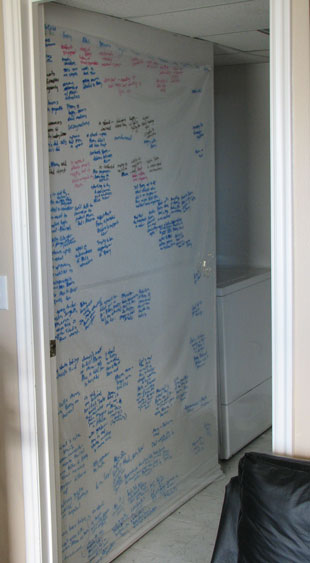I tried this new outlining thing yesterday. I’ve been less and less satisfied with my old outlining process lately–it’s all well and good to get the plot down, but especially for my more character-centric books, it’s hard to keep track of what every character is supposed to be doing and thinking all the time. I end up leaving out side characters entirely, their motivations pop in and out in early drafts. The same is true of plot threads. Even though I write with an outline, I end up having to go back and re-outline before each revision.
The last re-outline I did involved a piece of paper with arcs drawn all over it in a sort of timeline. That was helpful, but doing these things on paper meant it was hard to move things around in a fluid way. And I haven’t found a computer program with the kind of free-moving elements I want when I’m outlining. I want to be able to draw arrows and write notes in margins, and that’s really more a by-hand kind of thing.
What I really wanted was to use a big wall-sized space. I had this idea of using post-its, but the post-its fall off and flutter away and are generally annoying. Taping them all to the wall was way too much work.
Enter my big wall of plastic. I went to Wal-mart (though any fabric store will do) and bought two yards of clear plastic sheeting, the kind one can use to cover tables. Then I tacked it to my laundry room wall and went at it with dry erase markers. (FYI, I discovered later that wet-erase markers are easier to erase on this surface, but they don’t write as well. Take your pick.)
For this outline, I wrote the plot events down the left side of the wall and the characters across the top. For each plot event, I filled in what each of the applicable characters are thinking, feeling, and doing. This way I haven’t forgotten anybody at any stage of the book. I can tell where I’ll need one scene for the actual plot event, containing the reactions and complications of the present characters, and where I’ll need to add additional scenes for the non-present characters to talk and react about what’s going on. I’ve got not just my plot arc outlined, but also a full arc for each character in the book, down to the very minor ones. I changed a lot of things as I went, but I could erase and move elements easily.
Since the wall-outline would by pretty unwieldy for actual writing, I typed it all into a spreadsheet today. I don’t like the spreadsheet for composing, because it’s so hard to look at the whole thing at once, but it’s a nice portable record now that I’ve got it all set.
It took some elbow grease getting the dry erase marker off the plastic (really, next time I’m using wet erase. I’m also going to be more intentional about my color coding–probably one color per character). I’m not sure how this would work for a book with multiple viewpoints. (I don’t write those.) Maybe one color per viewpoint? If anyone tries it, let me know how it goes.
This afternoon I started writing another novel outline up on my wall–one I’ve had outlined and tried to write, but wasn’t developed enough to be a successful first draft. For that one, I’ve written both the characters and the different plot threads along the top of the sheet, so I can keep track of not just the characters, but also the thematic elements. As I fill in the sheet, I can tell when certain characters or elements fall out of the story for chapters at a time, and make decisions about whether or not that’s what I want them to do.
The process helped me find the problem in my second outline: the first four characters are really fleshed out, but the rest of the arcs are all but empty. Guess I have some invention to do on that one. My wall may be staying up for a while, while the ideas percolate.

